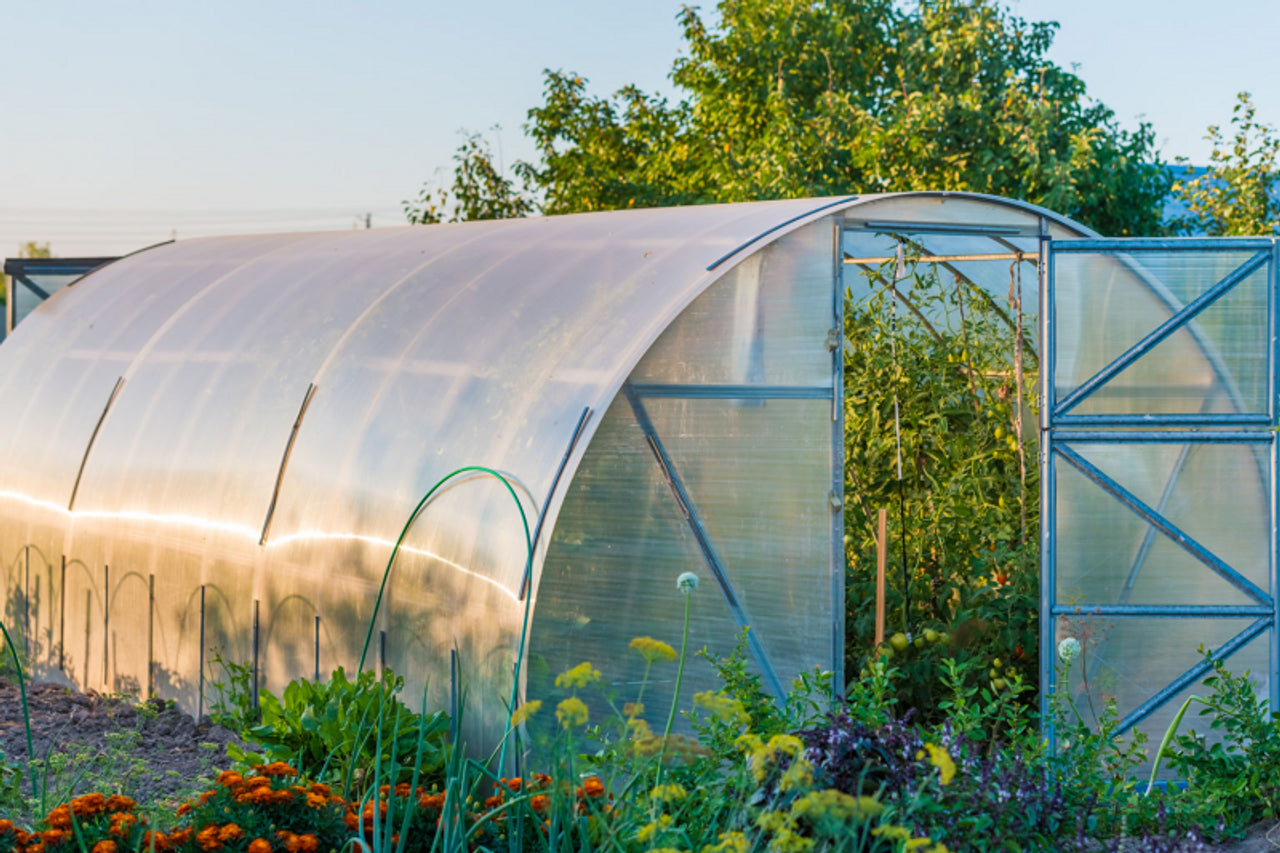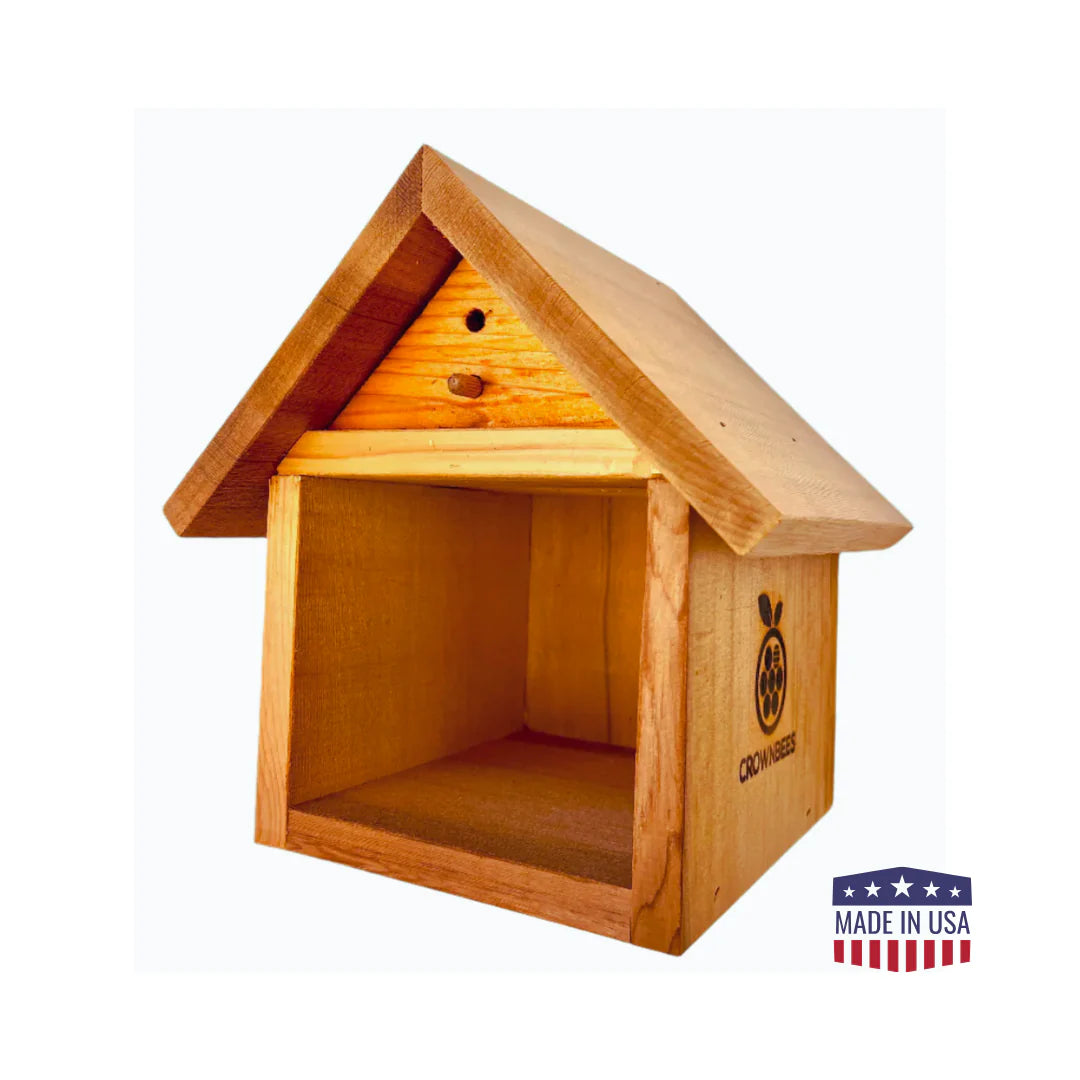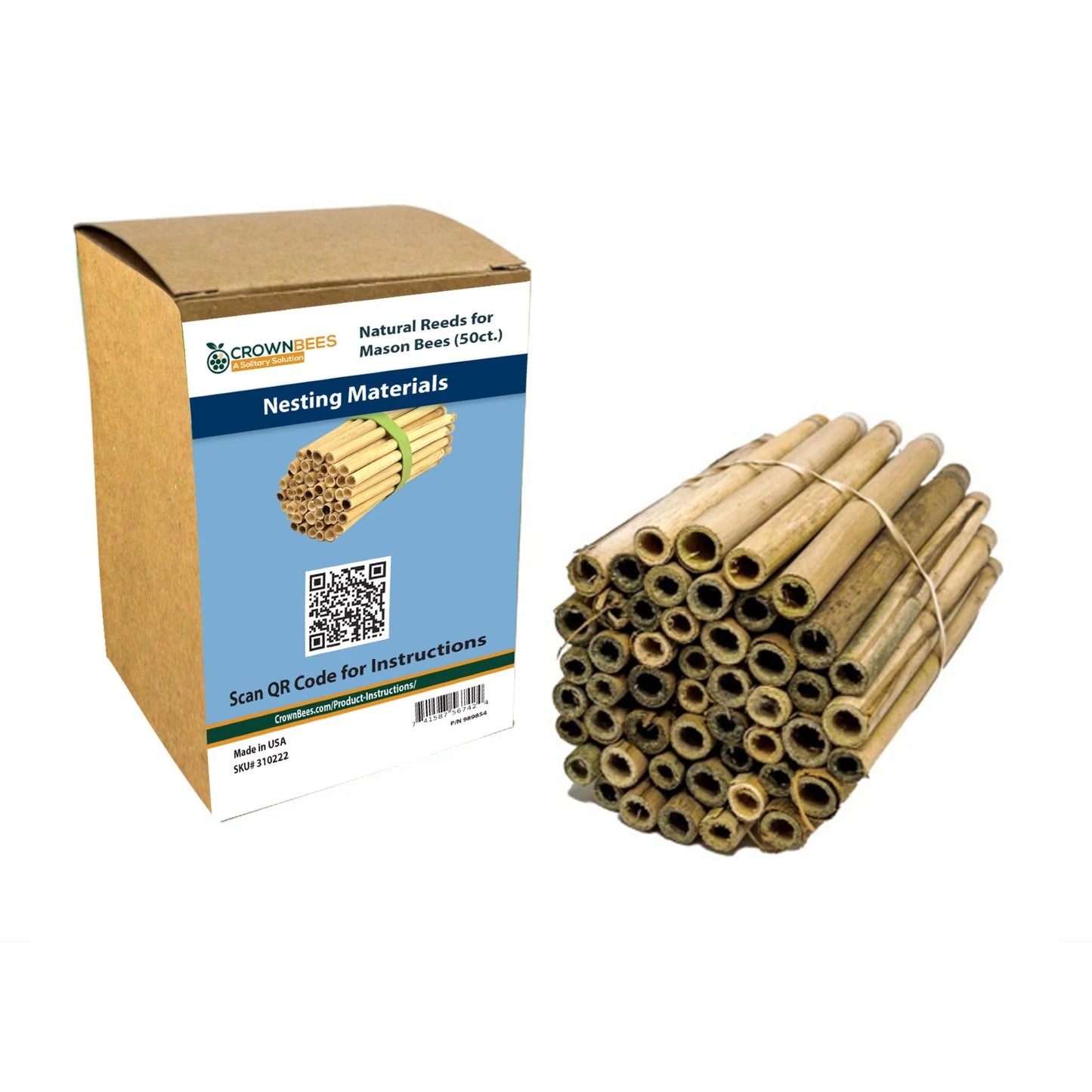
If you have a greenhouse, pollination can be a struggle. After all, 1/3 of the food we eat is dependent on pollinators, and without them, you'll be pollinating your greenhouse plants by hand with a paintbrush. So, it's no wonder that many of our bee raisers ask us if they can raise mason and leafcutter bees in greenhouses, high tunnels, and hoop houses.
Bumble bees have historically been the bee of choice for many mid to large size greenhouse growers. However, recent research suggests that cavity-nesters such as mason and leafcutter bees can function well in covered environments.
But, it's important to note that raising bees in enclosed environments can negatively affect pollinator health, including lower reproduction rates, adult mortality, reduced foraging, and increased disease prevalence. Adverse effects occur due to changes in temperature/humidity, light quality/quantity, pesticide exposure, and reduced access to floral resources. But, don't worry. We'll tell you a few tips and tricks to prevent these harmful effects throughout this article.
Bees have not evolved to live in enclosed spaces, so they will not be as efficient inside enclosed areas as outside. Still, even when limited, natural pollination inside greenhouses is better than hand-pollination. And with the proper care and maintenance, you can give your solitary bees what they need to do well and effectively pollinate your space.
So, let's dive into what mason and leafcutter bees need in your greenhouse, high tunnel, or hoop house to be successful.
What Bees Need in Your Greenhouse, High Tunnel, or Hoop House
1. UV Positive Environments
Many of today's greenhouses, high tunnels, and hoop houses use UV blocking materials or have UV blocking shields. But, blocking UV reduces the amount of polarized light in the enclosure and hinders the bees ability to find flowers and navigate to their nests.
Bees have five eyes, made up of two sets – compound eyes and simple eyes. Compound eyes are the big eyes on the side of the head, which bees use to see their environments, like colors and ultraviolet light. Simple eyes, or ocelli, are the three little eyes in the shape of a triangle on top of a bee's head and are made up of one lens each. They detect polarized light so that the bee can judge direction and distance — these are the eyes that help the bees relocate their nests when out foraging.

Bees use polarized light to relocate their nests. Polarized light moves in one direction, creating distinct patterns in the sky. While this doesn't seem like much to us (since most humans can't see polarized light), bees can scan and match the polarization patterns in the sky to find their way home — like Google Maps for bees. Even more impressive is that bees can use polarized light to navigate even when the sun isn't shining!
Now, many greenhouses add artificial lighting to enhance growth. While this is beneficial to the plants, it can mess with a bee's navigation ability, and you may see reduced pollination and reproduction. If you have a greenhouse that only uses artificial light, the bees will not do well, and you should seek alternative ways to pollinate your crops.
Bees' ability to see ultraviolet light helps them find nectar. Many flower patterns are invisible to humans but look like a food "bulls-eye" to bees. This "bee vision" makes finding nectar much easier — some flowers such as sunflowers, primroses, and pansies have flower patterns that are only visible in ultra-violet light. So, when you block out UV light, you block the bees' ability to locate flowers efficiently.
Secondly, orientation toward UV light may also contribute to many bees escaping through ventilation systems. In greenhouses with UV-blocking coverings, the UV light shining from open vents, windows, and doors lures the bees to these escape paths. Once the bees leave the greenhouse, they're unlikely to return.

2. Seal Openings to Outside With Netting
Bees prefer outdoor environments and will find a way to escape a greenhouse. And as we mentioned above, they will be naturally drawn to the UV light, making finding the escape routes a breeze. To prevent bees from flying off, you can cover vents and holes with a fine netting such as mosquito netting or screening.
If you have a smaller greenhouse like the one below, you can always place your solitary bees directly outside your greenhouse and leave windows open to allow bees to come and go as they please. As you'll read later in this post, access to the outdoors is beneficial to the bees for many reasons.

3. Lots of Flowers
Each female bee can visit 2,000 or more open flowers per day. Make sure that you are growing enough flowers to feed your bees. If your structure is smaller, you can raise fewer bees to ensure that they are not competing with each other for pollen and nectar. Each nesting bee needs about 1 square yard/meter of blooming flowers each day.
Researchers are beginning to investigate the specific microbes bees need their young to consume during development. If certain microbes are missing, it may cause larvae to be unfit or even die before reaching maturity. In restricted greenhouse settings, microbes that can move from flower to flower outside may be missing inside. However, we do know that bees need a diversity of proteins and micronutrients from pollen, which isn't available in enclosures with all the same plants (e.g., an entire greenhouse of strawberry plants). Floral diversity reduces parasitism, increases reproduction, and increases crop pollination activity.
Consider including various floral resources if you want your bees to do well in your greenhouse, high tunnel, or hoop house. Even a few hanging pots of different types of flowers can help add a different pollen source!

4. Temperature and Humidity
Cavity-nesting bees use temperature cues to emerge and develop, so for your mason and leafcutter bees to be successful, you'll need to have the correct temperatures and humidity levels in your greenhouse, high tunnel, or hoop house. Suppose you can't modify the temperature and humidity in your covered system to meet the needs of the specific bee species you'll be using. In that case, you should consider alternative pollination tactics.
Mason Bees
- Our mason bee season runs from late January to the end of April.
- Mason bees are spring bees and need daytime temperatures around 55° - 80° F/13° - 27° C. If your enclosure is warmer than 80° F/27° C, mason bees will not do well, and you should consider leafcutter bees.
- Mason bees don't typically do well in consistently humid conditions.
- Mason bees only produce one generation of bees per year. Their larvae need the warm summer temperatures to develop into adult bees fully. Once they do, you should harvest your mason bee cocoons and store them in your refrigerator until the following spring. The consistent cold temperatures of your fridge help the mason bees conserve their fat stores over the winter. They'll quickly use up their fat stores and emerge before you need them if you don't keep them cool over the fall and winter.
- Make sure you read our Mason Bee Raiser Calendar to learn what these bees need to survive. The requirements are the same both inside an enclosure and outside in an open environment.
Leafcutter Bees
- Our leafcutter bee season runs from May to the end of August.
- Leafcutter bees are summer bees and need daytime temps around 75°F/24°C - 100°F/38°C. If your enclosure is cooler than 75°F/24°C, leafcutter bees will not do well, and you should consider mason bees.
- Humidity is OK for leafcutter bees.
- Leafcutter bees can produce a second generation of bees if the temperatures remain warm, making them a good bee to use in greenhouses that need extended summer pollination.
- Make sure you read our Leafcutter Bee Raiser Calendar to learn what these bees need to survive. The requirements are the same both inside an enclosure and outside in an open environment.
Besides directly influencing pollination and nesting, both temperature and humidity affect the production of pollen and nectar by flowers and, consequently, can reduce bees' foraging behavior. High temperatures and high relative humidity can lower the sugar concentration of nectar, making the flowers less attractive to pollinators and reducing pollination.

5. Nesting Materials and Nest Building Materials
Cavity-nesting bees build their nests inside tunnels left behind by insects, in the hollow stems of certain plants, and in artificial nesting materials such as cardboard and paper tubes. For your bees to thrive in greenhouses, high tunnels, and hoop houses, you'll need to ensure they have the necessary materials to build their nests.
You don't necessarily need a house for the nesting materials unless you have overhead sprinklers. Although, you may prefer to place a few houses around your enclosure to keep the nesting materials organized. Suppose you have a large enclosure, space out smaller bundles of nesting materials - but make sure they are easily seen (eye level or just above flowers is a good height). That way, the bees don't feel overcrowded.
Nesting materials sealed at one end, breathable, thick-walled, and easily opened are the best way to protect bees from pathogens and parasites such as excessive mold, chalkbrood, parasitic wasps, and pollen mites. Click here to learn more about bee-safe nesting materials.
Female mason bees build the walls of their nesting chambers out of mud or other "masonry" products to give each developing bee its own room in the nesting chamber. So, if you're using mason bees, you'll need to make sure there is a source of clay-rich mud within 10 feet of your nesting materials. The wet soil from your plants typically doesn't have a high clay content. Click here to learn the correct type of mud to use.
Leafcutter bees can use the leaves of almost any broadleaf deciduous plant to construct their nests. However, they prefer soft, flexible leaves and flower petals, such as alfalfa, clover, buckwheat, roses, peas, lamb's quarters, lilac, redbud trees, or hostas.
If you have soft, deciduous leaves in your enclosure, there is no need to cut the leaves and bring them to the bees. The bees will find what they need. However, if the crops within the enclosure don't have the correct leaves, you can bring in fresh-cut branches of leaves for the leafcutters to use. However, once they begin to wilt, you'll need to swap them out for new ones. Bringing in sacrificial potted plants like a rose or hostas will save you the hassle of continuously swapping out cut branches.

6. Chemical Free Area
We understand that pesticide application is a common management practice for most crops grown in an enclosed environment and is sometimes even necessary. Still, the negative impacts of pesticide exposure on pollinator health are well-known. Understand that bees will not do as well and may even die outright if you use pesticides in your greenhouse, high tunnel, or hoop house.
We hope this information is helpful! All in all, there are a lot of factors that play into whether bees of any kind will do well in your greenhouse, high tunnel, or hoop house. Ultimately, what works for one person, may not work for another.
Fortunately, researchers are finally starting to look at using bees to pollinate enclosed spaces, and as we learn more, we'll pass that information on to you! But, don't wait for the researchers to experiment with these efficient pollinators in your greenhouses. With a little trial and error, you'll be able to find what works for your space, region, and crops!
Good luck and happy pollinating! And, don't hesitate to reach out if you have any questions or want to share your success stories (we love to hear them)!
To stay up-to-date on bee-raising tips and reminders, events, pollinator research, and sustainability insights, sign up for our monthly BeeMail newsletter and follow us on social media!


